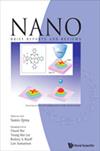聚乙二醇包覆Fe3O4纳米颗粒磁热疗效率的评价
IF 1.1
4区 材料科学
Q4 MATERIALS SCIENCE, MULTIDISCIPLINARY
引用次数: 0
摘要
磁性纳米粒子热疗在癌症治疗中引起了相当大的兴趣。在这项研究中,我们报道了聚乙二醇包覆的fe3o4纳米颗粒的合成,并评估了它们在磁热疗应用中的适用性。采用化学共沉淀法合成了fe3o4纳米颗粒,并在表面涂覆聚乙二醇(PEG)。采用x射线粉末衍射(XRD)、傅里叶变换红外光谱(FTIR)、振动样品磁强计(VSM)、动态光散射(DLS)和透射电子显微镜(TEM)对peg包覆的fe3o4纳米颗粒进行了表征。合成的纳米颗粒具有反尖晶石结构,晶粒尺寸为9.1 nm。M-H磁滞回线证实了合成的fe3o4纳米颗粒具有超顺磁性。裸露的fe3o纳米颗粒的物理尺寸,由HR-TEM测定为[公式:见文][公式:见文]nm,而相应的peg包覆的fe3o纳米颗粒的流体力学尺寸为[公式:见文][公式:见文]nm。研究了聚乙二醇包覆的fe3o4纳米颗粒的磁热疗效率与磁场频率(162 ~ 935.6 kHz)、磁场强度(5 ~ 12 mT)和纳米颗粒浓度(1 ~ 100 mg/mL)的关系。在peg包覆的fe3o4纳米颗粒的水分散体中测量了20分钟的温升[公式:见文本]。采用修正斜率法计算比损耗功率(SLP)。peg包覆的fe3o4纳米颗粒的SLP值随磁场频率和磁场强度的增大而增大,随纳米颗粒浓度的增大而减小。在935.6[公式:见文]kHz频率、10[公式:见文]mT场强和25[公式:见文]mg/mL浓度下,peg包被的fe3o4纳米颗粒的热疗性能最佳。在此条件下,聚乙二醇包覆的fe3o4纳米颗粒的SLP为4.43 W/g。这些结果表明,合成的聚乙二醇包覆的fe3o4纳米颗粒可能是磁性热疗治疗癌症的潜在候选者。本文章由计算机程序翻译,如有差异,请以英文原文为准。
Evaluation of Magnetic Hyperthermia Efficiency of PEG-Coated Fe3O4 Nanoparticles
Magnetic nanoparticle hyperthermia has drawn considerable interest in cancer therapy. In this study, we report the synthesis of PEG-coated Fe 3 O 4 nanoparticles and evaluate their suitability for magnetic hyperthermia applications. Fe 3 O 4 nanoparticles were synthesized by the chemical coprecipitation method, which are coated with polyethylene glycol (PEG). PEG-coated Fe 3 O 4 nanoparticles were characterized by X-ray powder diffraction (XRD), Fourier transform infrared spectroscopy (FTIR), vibrating sample magnetometer (VSM), dynamic light scattering (DLS) and transmission electron microscopy (TEM). Synthesized nanoparticles possess inverse-spinel structural with a crystallite size of 9.1[Formula: see text]nm. From the M-H hysteresis loops, it was confirmed that the synthesized Fe 3 O 4 nanoparticles were superparamagnetic. The physical size of bare Fe 3 O 4 nanoparticles, as determined from the HR-TEM, is [Formula: see text][Formula: see text]nm, and the corresponding hydrodynamic size of PEG-coated Fe 3 O 4 nanoparticles is [Formula: see text][Formula: see text]nm. Magnetic hyperthermia efficiency of PEG-coated Fe 3 O 4 nanoparticles was determined as a function of magnetic field frequency (162–935.6[Formula: see text]kHz), field strength (5–12[Formula: see text]mT) and nanoparticle concentration (1–100[Formula: see text]mg/mL). Temperature rise in an aqueous dispersion of PEG-coated Fe 3 O 4 nanoparticles was measured for 20[Formula: see text]min. The specific loss power (SLP) was calculated by the corrected slope method. SLP values of PEG-coated Fe 3 O 4 nanoparticles increase with magnetic field frequency and field strength and decrease with nanoparticle concentration. The optimum hyperthermia performance of PEG-coated Fe 3 O 4 nanoparticles was observed for 935.6[Formula: see text]kHz frequency, 10[Formula: see text]mT field strength and 25[Formula: see text]mg/mL concentration. Under these conditions, the measured SLP of PEG-coated Fe 3 O 4 nanoparticles was 4.43[Formula: see text]W/g. These results show that the synthesized PEG-coated Fe 3 O 4 nanoparticles could be a potential candidate for magnetic hyperthermia treatment of cancer.
求助全文
通过发布文献求助,成功后即可免费获取论文全文。
去求助
来源期刊

Nano
工程技术-材料科学:综合
CiteScore
2.10
自引率
0.00%
发文量
95
审稿时长
1.6 months
期刊介绍:
NANO is an international peer-reviewed monthly journal for nanoscience and nanotechnology that presents forefront fundamental research and new emerging topics. It features timely scientific reports of new results and technical breakthroughs and also contains interesting review articles about recent hot issues.
NANO provides an ideal forum for presenting original reports of theoretical and experimental nanoscience and nanotechnology research. Research areas of interest include: nanomaterials including nano-related biomaterials, new phenomena and newly developed characterization tools, fabrication methods including by self-assembly, device applications, and numerical simulation, modeling, and theory. However, in light of the current stage development of nanoscience, manuscripts on numerical simulation, modeling, and/or theory only without experimental evidences are considered as not pertinent to the scope of NANO.
 求助内容:
求助内容: 应助结果提醒方式:
应助结果提醒方式:


